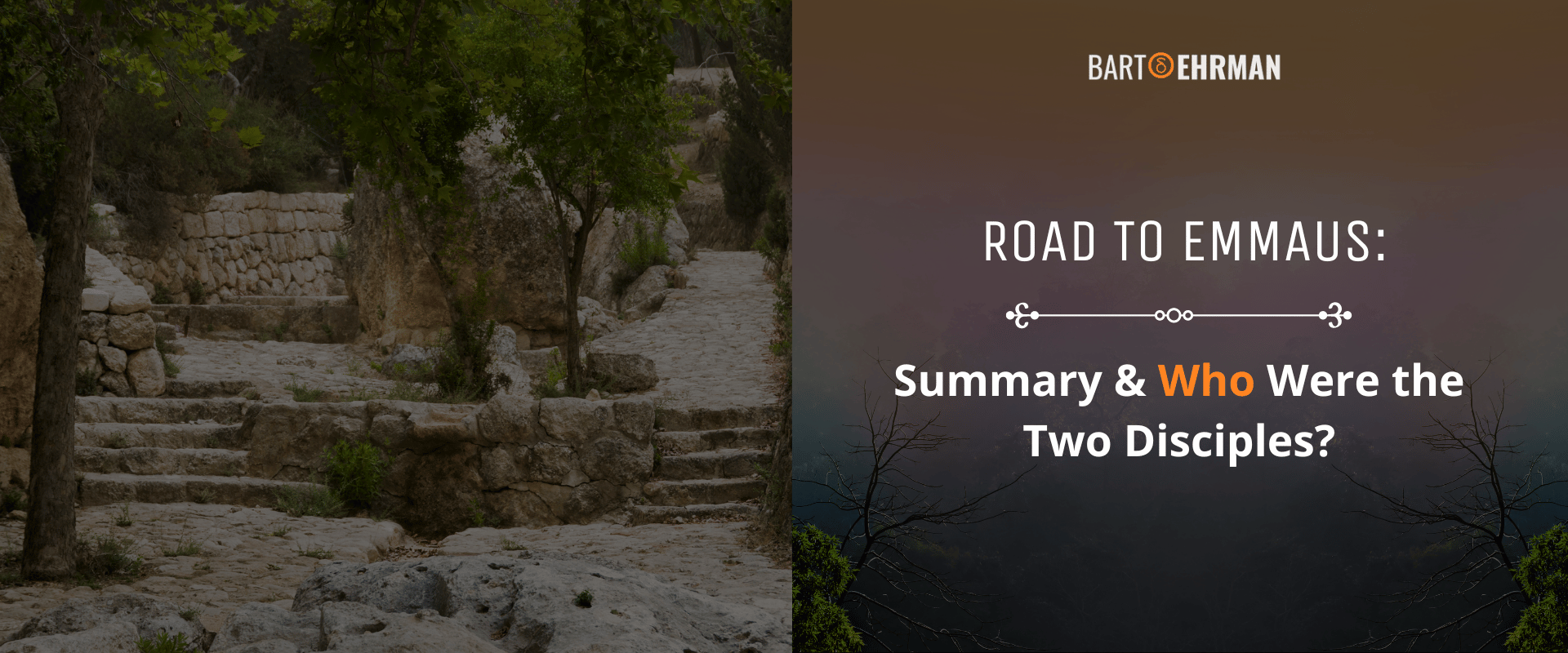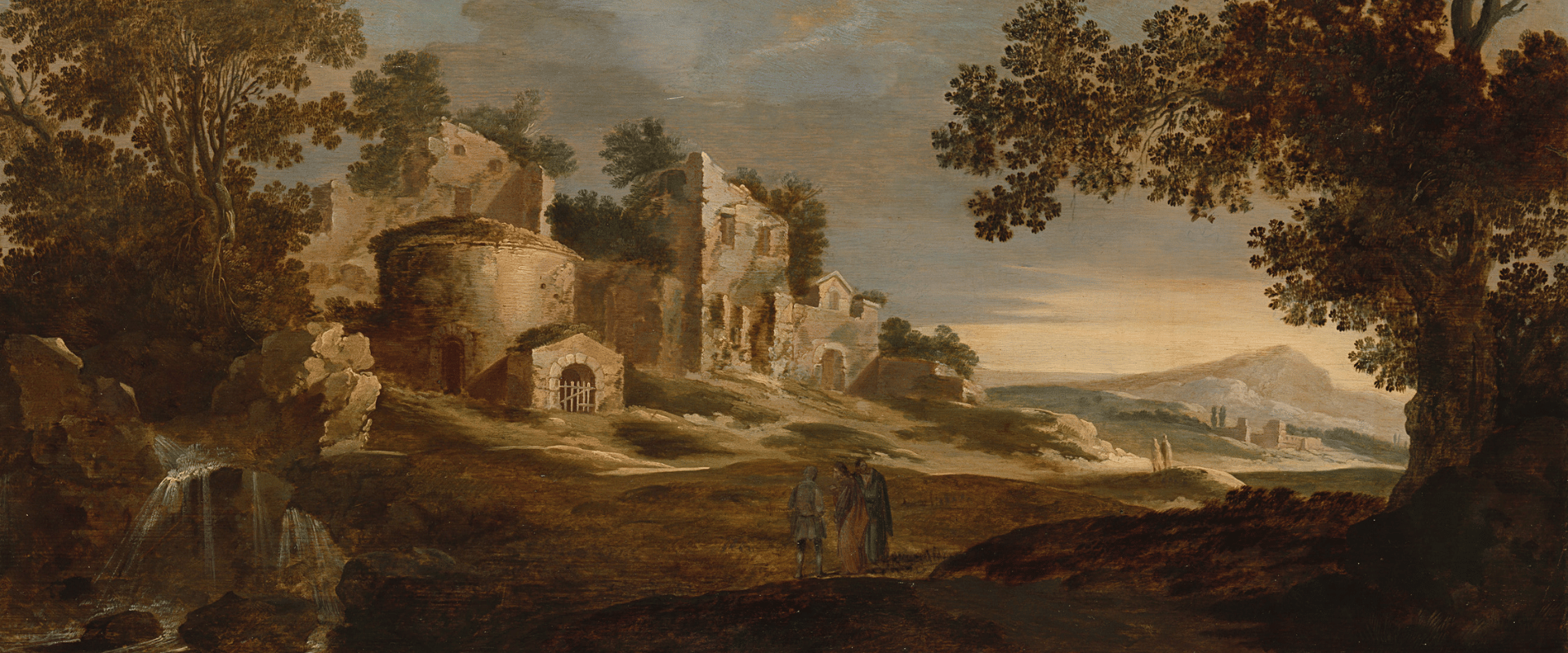Road to Emmaus: Summary & Who Were the Two Disciples?

Written by Marko Marina, Ph.D.
Author | Historian
Author | Historian | BE Contributor
Verified! See our guidelines
Verified! See our editorial guidelines
Date written: October 2nd, 2024
Edited by Laura Robinson, Ph.D.
Disclaimer: The views and opinions expressed in this article belong to the author and do not necessarily match my own. - Dr. Bart D. Ehrman
Just the other day, I was watching “The Chase” on our national TV station, feeling confident in my usual trivia prowess. I tend to do well on these quizzes, but my biggest flaw is that I sometimes rush to answer before I’ve thought it through.
So, when the question popped up: “According to the Gospel of Luke, where did the risen Jesus first appear to his disciples?”, I blurted out, without hesitation, “Jerusalem!” To my family’s amazement, I was wrong. The correct answer? “On the road to Emmaus.”
As a historian of early Christianity, my family looked at me with the kind of disbelief reserved for someone who’s just forgotten their birthday.
How could I possibly get that wrong? But the truth is, Emmaus is one of those mysterious places in the New Testament — mentioned briefly, yet holding immense rhetorical and literal significance. Even though it's easy to get mixed up, the story of Jesus on the road to Emmaus deserves more than a passing glance.
In this article, we’ll dive into this fascinating event from the Gospel of Luke, exploring what makes it so important and puzzling from a historical standpoint.
Who were the disciples Jesus appeared to? What do we really know about the location of Emmaus? And why has this story remained such a vital part of Christian tradition? Let’s take a walk down that ancient road together and see what we can uncover.

The Road to Emmaus: Story Overview
The story of the road to Emmaus is found in the Gospel of Luke, specifically in chapter 24, verses 13-35. This Gospel was likely written 50 to 60 years after Jesus' death, by an anonymous Christian author living outside of Palestine.
Although traditionally attributed to Luke, the companion of Paul, modern scholarship recognizes that the writer’s identity remains uncertain. The author’s purpose was to present an account of Jesus' life and teachings to a Christian community spread across the Greco-Roman world, far from the land where the events took place.
In Luke’s account, the story unfolds on the same day as the resurrection, just after the women had found the empty tomb.
Two of Jesus’ followers are walking from Jerusalem to a village called Emmaus. They are deep in conversation, discussing the recent events surrounding Jesus' crucifixion and the rumors of his resurrection. As they walk, a stranger joins them, though, as the text notes, “they were kept from recognizing him” (24:16).
The stranger asks them what they are discussing, and they express their disappointment and confusion. They had hoped Jesus was the one who would redeem Israel, but instead, he had been crucified. Even though some women from their group reported seeing an empty tomb, the two disciples remain uncertain and disheartened.
The stranger then begins to explain to them the Scriptures, thus showing how they foretold the Messiah's suffering.
As they approach Emmaus, the two disciples invite the stranger to stay with them for the evening. It’s during dinner, when he breaks bread, that their eyes are finally opened, and they realize it’s Jesus. As the author asserts: “Then their eyes were opened, and they recognized him, and he disappeared from their sight” (24:31).
In amazement, the two disciples immediately return to Jerusalem to share the news with the eleven apostles, proclaiming, “It is true! The Lord has risen and has appeared to Simon” (24:34).
Who Were the Two Disciples?
Historians have long been intrigued by the question: “Who were the two disciples on the road to Emmaus?”
The text leaves us wanting more information about their identity and background, but unfortunately, the evidence is scant. As much as we’d like to draw concrete conclusions, the lack of historical records limits our understanding. Scholars can only speculate based on the few details from the Gospel of Luke.
What can we say for sure? First, these two disciples were not part of Jesus’ inner circle — the Twelve. Only one of them is named explicitly: Cleopas. This suggests that both were likely among the broader group of Jesus' followers, beyond the Twelve.
Scholars generally agree that the historical Jesus had other followers who played important roles in his ministry. This is reinforced by the fact that Cleopas and his companion were close enough to the inner circle to be aware of the events in Jerusalem but weren’t among the apostles.
Still, their inclusion in this story highlights that Jesus’ resurrection appearances weren’t confined to the Twelve, expanding the circle of witnesses to include others who had followed him.
Michael Wolter, in his Commentary on Luke, offers an interesting thesis regarding the identity of the second, unnamed disciple. He argues that Luke may have introduced this second disciple “ex nihilo” to fulfill a common principle in ancient Jewish legal practice: The requirement of two witnesses to confirm the truth of an event. (Affiliate Disclaimer: We may earn commissions on products you purchase through this page at no additional cost to you. Thank you for supporting our site!)
By doing so, Luke provides a narrative framework that satisfies both theological and cultural expectations. Wolter’s suggestion (which, of course, can’t be proven) reminds us that the Gospel narratives were shaped by both the traditions they inherited and the needs of their communities, emphasizing the importance of multiple witnesses to the resurrection.
As we move forward, we’ll dive into a historical interpretation of the story. We’ll examine how it reflects the early Christian community's beliefs and what it reveals about the post-resurrection appearances of Jesus. Let's now turn our attention to the broader historical and literary context of this narrative.
FREE COURSE!
WHY I AM NOT A CHRISTIAN
Raw, honest, and enlightening. Bart's story of why he deconverted from the Christian faith.
Over 6,000 enrolled!
Jesus on the Road to Emmaus: Historical Analysis
“A little masterpiece of dramatic narrative” — this is how French scholar Maurice Goguel describes Luke's Road to Emmaus story. And, as always, French scholars have a way with language and epithets! Their books are often as rich in descriptions as in nuance.
Behind this elegant formulation, however, lies a serious issue related to the miraculous character of the Emmaus story. From a historian's point of view, the question of historical accuracy is bound by its supernatural elements (i.e. the appearance of the risen Jesus).
As Bart D. Ehrman explains in his book The New Testament: A Historical Introduction, the historicity of miracles is beyond the scope of historical investigation. He writes:
Since historians can only establish what probably happened in the past, and the chances of a miracle happening, by definition, are infinitesimally remote, historians can never demonstrate that a miracle probably happened… The problem of historical probabilities restrains our conclusion.
So, while we might love to know if Jesus actually appeared to the two disciples on the road, history can only take us so far. With this in mind, let’s explore the story more closely from both a literary and historical perspective.
Scholarly Insights
The Mystery of Emmaus
Scholars have long debated the exact location of the village of Emmaus mentioned in the Gospel of Luke, and the truth is, we may never know for sure where it was! According to Luke, Emmaus was “sixty stadia” from Jerusalem — about eleven kilometers. Sounds precise, right? Well, not so fast.
Ancient authors often used standardized distances like sixty stadia more as estimates of travel time rather than specific geographical markers. In other words, “sixty stadia” could have been a rough figure indicating a two-hour walk instead of a pinpointed location on a map.
To complicate things further, people have proposed multiple locations as the historical Emmaus, including Nicopolis, el-Qubebeh, and Abu Ghosh. Yet each of these candidates has its problems — whether it’s the distance from Jerusalem, lack of supporting tradition, or textual inconsistencies.
Some scholars even suggest that Luke might not have been referring to a specific place at all but rather drawing on a tradition without firsthand knowledge of Emmaus' actual geography. So, while Emmaus remains elusive in a literal sense, its symbolic role in the story of the risen Jesus is crystal clear.
First, it’s worth noting that Luke is the only Gospel where the risen Jesus enlightens his followers in such a dramatic fashion. The story of Jesus on the Road to Emmaus marks one of the key post-resurrection appearances, and it’s rich in symbolic meaning.
As Joel B. Green highlights in his Commentary on the Gospel of Luke, recognition is the central theme of this story. The two disciples initially failed to recognize Jesus, both physically and in terms of understanding his mission.
It’s only when he breaks bread that their eyes are opened, and they realize who he is. Green sees this act as both a physical and theological revelation. He links it to the Last Supper — a moment laden with significance for early Christians. The breaking of bread symbolizes not just a meal but a newfound understanding of Jesus' true identity.
The narrative also emphasizes the disciples' profound misunderstanding of the events that had just taken place. They are disheartened because they believed Jesus was the one who would redeem Israel (24:21), only to see him crucified.
When Jesus rebukes them for being “foolish” and slow to believe what the prophets had foretold (24:25), he reinterprets their understanding of the Messiah. As Michael Wolter points out, Luke’s overall Christology views Jesus' suffering as an essential part of his messianic mission. In this narrative, the suffering Messiah is not a tragic failure but a necessary step toward entering his glory (24:26).
The disciples’ lack of understanding is ultimately corrected through both Scripture and the physical act of breaking bread, where recognition, as we mentioned above, finally dawns.
But there’s an interesting twist in how Luke presents the story. Before the Emmaus disciples can even share their experience, Luke interrupts the narrative by inserting a report that Jesus has already appeared to Peter. Why would Luke do this?
According to Wolter, Luke is aware of the early Christian tradition that the apostle Peter was the first to witness the risen Jesus (1 Cor 15:5), and, by placing the report of the Emmaus disciples after Peter’s encounter, he emphasizes the importance of Peter’s role in grounding Christian Easter faith.
In other words, this narrative decision serves to balance the tradition of Peter’s primacy with the significance of the Emmaus story, where the disciples’ eventual recognition of Jesus becomes a powerful metaphor for the early Christian community’s understanding of the resurrection.
The Road to Emmaus story, then, isn’t just about physical appearances but deeper revelations concerning the nature of Jesus’ mission and the alleged fulfillment of Scripture.
Now, turning back to the question of historical credibility: can we say this event happened as described? While historians can't decide whether the risen Jesus actually appeared to these two disciples, they can analyze the story's origins.
Was this episode a Lukan creation, or does it have earlier roots in Christian tradition? Some scholars, such as E. L. Allen, suggest that the Emmaus story might not represent a specific event on the first Easter but rather a "crystallization of many such experiences of meeting the Lord in the breaking of bread." As is often the case in ancient history, we simply can’t know for sure.
The story may have originated shortly after Jesus’ death among his early followers, or it could be a later addition by the author of Luke to emphasize theological themes. Either way, the lack of solid evidence leaves the door open for interpretation.

Conclusion
Just like my fumbled answer on “The Chase,” the story of the road to Emmaus reminds us how easy it is to overlook details or miss the bigger picture — especially when it comes to matters of history and Christian origins. Scholars may never agree on the exact location of Emmaus, nor can they confirm the historical accuracy of miraculous events.
However, what the story offers is more than just a geographical or historical puzzle; it’s a profound narrative about recognition, revelation, and understanding.
Just as I misjudged where Jesus first appeared, so, too, did the two disciples on the road misjudge the events they had witnessed. It wasn’t until the breaking of bread that their eyes were opened, much like how historical study, over time, brings us closer to understanding the complexities of early Christian history.
For a deeper exploration of the Gospels and their historical contexts, I highly recommend Dr. Bart D. Ehrman’s online course "The Unknown Gospels: Matthew, Mark, Luke, and John". In eight captivating lessons, Dr. Ehrman sheds light on the lines between history, tradition, and myth in the New Testament Gospels thus offering a richer understanding of these ancient texts that provides a small window into the life of Jesus and his first followers!
FREE COURSE!
WHY I AM NOT A CHRISTIAN
Raw, honest, and enlightening. Bart's story of why he deconverted from the Christian faith.
Over 6,000 enrolled!
